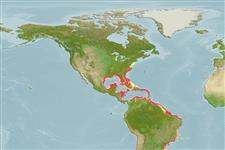>
Mulliformes (Goatfishes) >
Mullidae (Goatfishes)
Etymology: Pseudupeneus: Greek, pseudes = false + Peneus, the name of a river.
More on author: Bloch.
Environment: milieu / climate zone / depth range / distribution range
Ökologie
seewasser riff-verbunden; tiefenbereich 0 - 90 m (Ref. 9626), usually 0 - 35 m (Ref. 40849). Subtropical; 40°N - 30°S, 98°W - 28°W
Western Atlantic: Bermuda and New Jersey, USA to Santa Catarina, Brazil (Ref. 57756), including the Gulf of Mexico and throughout the Caribbean Sea (Ref. 9626).
Length at first maturity / Size / Gewicht / Alter
Maturity: Lm 18.0 range ? - ? cm
Max length : 30.0 cm TL Männchen/unbestimmt; (Ref. 7251); common length : 22.0 cm TL Männchen/unbestimmt; (Ref. 3792)
Rückenflossenstacheln (insgesamt) : 8 - 9; Rückenflossenweichstrahlen (insgesamt) : 8. A series of three large blackish blotches on upper side of body beneath dorsal fins; color variable but usually pale, the scales of the back with reddish or yellowish brown edges and a central pale blue spot; diagonal light blue lines on head. Capable of displaying a pattern of large red blotches on head and body in less than a minute (Ref. 13442).
Inhabits shallow waters to depths of 90 m (Ref. 9626), especially over sand and rock bottoms in reef areas. Young juveniles often found on beds of seagrass, e.g. Thalassia. Feeds on small invertebrates (Ref. 9626). Flesh highly esteemed; marketed fresh and frozen (Ref. 3792). Traded as an aquarium fish at Ceará, Brazil (Ref. 49392).
Spawnng may either be in pairs or in small groups (Ref. 240).
Cervigón, F., 1993. Los peces marinos de Venezuela. Volume 2. Fundación Científica Los Roques, Caracas,Venezuela. 497 p. (Ref. 9626)
IUCN Rote Liste Status (Ref. 130435: Version 2024-2)
Bedrohung für Menschen
Reports of ciguatera poisoning (Ref. 30303)
Nutzung durch Menschen
Fischereien: kommerziell; Aquarium: Kommerziell
Tools
Zusatzinformationen
Download XML
Internet Quellen
Estimates based on models
Preferred temperature (Ref.
123201): 22.8 - 28, mean 26.4 °C (based on 680 cells).
Phylogenetic diversity index (Ref.
82804): PD
50 = 0.6250 [Uniqueness, from 0.5 = low to 2.0 = high].
Bayesian length-weight: a=0.01072 (0.00942 - 0.01219), b=3.10 (3.06 - 3.14), in cm total length, based on LWR estimates for this species (Ref.
93245).
Trophic level (Ref.
69278): 3.7 ±0.2 se; based on diet studies.
Widerstandsfähigkeit (Ref.
120179): hoch, Verdopplung der Population dauert weniger als 15 Monate. (K=0.3-0.7).
Fishing Vulnerability (Ref.
59153): Moderate vulnerability (35 of 100).
Nutrients (Ref.
124155): Calcium = 31.8 [14.4, 70.0] mg/100g; Iron = 0.495 [0.234, 0.896] mg/100g; Protein = 19.3 [17.5, 21.1] %; Omega3 = 0.259 [0.147, 0.488] g/100g; Selenium = 15 [7, 29] μg/100g; VitaminA = 72.6 [22.5, 282.5] μg/100g; Zinc = 0.77 [0.47, 1.18] mg/100g (wet weight);
